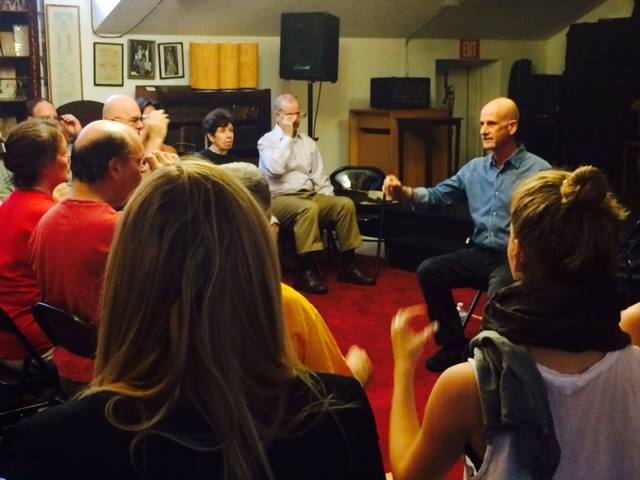
Alexander Technique-Happiness
The Alexander Technique and Happiness
F.M. Alexander (1869-1955), the developer of the Alexander Technique, would be fascinated by the emerging evidence of how thinking affects our brain, how our brain affects our body, and how our body affects our brain. Detailed brain imagery demonstrates that thinking is not a purely mental process; it is physical as well. Measurable, physical changes occur in our brains ‘just’ by thinking. In other words, we don’t “just” think. We change our brains, in function and structure, with our minds.
Practicing the Alexander Technique
When we think about something enough, Alexander Technique principles included, we strengthen associated neural pathways. Thinking changes specific areas of the brain, including areas that control our emotions. Because of the neural mind/body loop, we can affect our emotions by the way we think and move. We can actually practice both the mental and physical manifestations of happiness.
Let go of any neck tension.
As your neck muscles let go they will lengthen, letting your head go up.
Let your head slightly rotate forward, and move up.
A slight smile; Breathe out slowly and fully.
Alexander Technique and Breathing
Slowly exhale making a whispered ah sound.
Let the air come back in through your nose, silently.
Think of something that will make you smile.
By Mark Josefsberg-Alexander Technique NYC










Thanks Mark, this is a wonderful post. I love this: “we can affect our emotions by the way we think and move; by practicing both the mental and physical manifestations of happiness”. It’s interesting to think of happiness as something to practice; usually, we think of happiness as a result more than a process. Alexander Technique is a great way to both practice happiness and “obtain” happiness.
Hi Jennifer,
Yes, practice is an interesting word. As a musician I know we get better at whatever we practice. But what neuroscientists are showing us is that practicing indeed makes…better. This includes happiness, or reducing the time and intensity of unwanted negative emotions, when that’s our goal. I want to learn more about ’embodied neuroscience’; when the body sends signals to the brain. I think it’s incredibly relevant to the Alexander Technique. If you can lend me $750,000., I’d like to do a research study.
Do you know about the crowd-funding site called http://www.kickstarter.com ? This sort of money is possible to get if you can convince enough contributors to kick in the bucks a little bit at a time.
I think i’m a little late with my reply, Franis.
Thank you! That really is a great idea.
It would be interesting to look at this the other way round too – are people with dodgy posture unhappier than those with good posture? There’s got to be an MSc in that.
Hi Sharon,
It would be interesting. What do you think about that? Do you think people with dodgy posture would be shown to be unhappier?
I know how people who are twisted up feel worse physically – but then I also know people who are twisted who are determined not to allow their physical limitations to run their whole lives. Faking a smile eventually makes other people treat you as if you are happier, which results in you being happier as you respond to them genuinely.
You should ask Luke Ford about this – he’s convinced that A.T. definitely makes him happier and changes his mood radically when he’s in a funk to being happier.
Hi Franis,
Absolutely. that’s what I was talking about when I was discussing the bi-directionality of the mind/body connection. “…he’s convinced that A.T. definitely makes him happier and changes his mood radically when he’s in a funk to being happier.”
Exactly the point I was trying to make! Thanks for clarifying.
I feel that the Alexander Technique has made me feel happier because I know it has improved my posture and gait. By allowing my neck to be free and lengthen I feel better aligned and I move lighter on my feet and that certainly affects my mood!
Thanks Sue,
I’ve noticed the same things. The Alexander Technique makes me happier any time I think of the principles. Changing my breathing changes my mood, instantly. I’m also happier because the Alexander Technique helped relieve my severe neck pain. I love that you can just call on the Alexander Technique whenever you want!
I think part of us gets hurt when young and we tighten to numb ourselves.We develop misuse so we won’t cry, tremble, sweat or laugh too much (i. e. feel). So I think undoing those habits of holding by the Alexander Technique does lead to a more functional human, and a happier one.
But happiness means different things to different people -from the process of overcoming obsticles toward a goal of one’s choosing – to a good feeling. This means sometimes the Alexander Technique will make us feel “unhappy” in that we feel pain and anoyance as the habits unumb and disintegrate. Sometimes it makes people “happy” to swinch down good on their jaw.
Personally, I leave an Alexander Technique lesson or an AT moment (wait let’s take a moment to feel my neck) refreshed and happier. But my wife hates it and feels bad about the habit she just discovered. There are many versions of this.
Thanks so much for this input, Ken. Yes, happiness does mean different things to different people, and there are times when the ‘negative’ emotions are appropriate. Happiness can be a loaded word, and it might have different meanings for different people. The Alexander Technique also leaves me, and my students, refreshed and happier. If it didn’t, we wouldn’t keep returning to Alexander lessons, or Alexander Technique moments! I feel so fortunate to be able to use the Alexander Technique whenever I want.
Ken, the difference might be that your wife doesn’t do any moving or experimenting before she makes the judgment about how she’s feeling as a result of what she thinks she just did…but didn’t actually do. If a person observes and comes to a conclusion BEFORE they’ve done anything differently, (in fact, not wishfully) they’ll only notice their habitual limitations.
The justifications for doing a habit can be so airtight that it don’t allow anything new to happen. That’s the nasty stuff that you must trick, detour, lie to, resist, sidestep, etc. (You know, all those negative things you’re not supposed to ever do?!)
Thanks very much for your thoughts, Franis. I like that “airtight” idea. I think that’s true. The Alexander Technique attempts to get a little daylight in there!
Hi mark,
great blogs by you.
Hope,
the blogging percentage of alexander students and pupils increases, compared to alexander technique teachers blogging.
Hi Jagadish,
Glad you like the blog, and thank you!